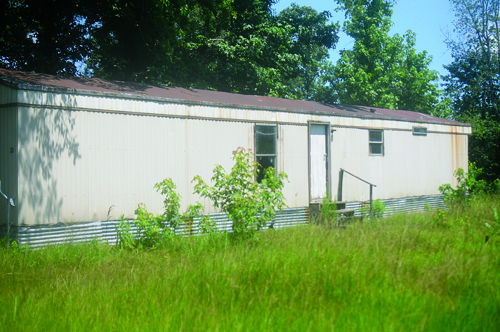NASHVILLE – Methamphetamine is reported to produce an intense, but brief high. The effects on the body are much more lasting, and contamination of properties where it has been manufactured can last for decades, according to scientists.
Both the Arkansas Department of Environmental Quality and the Drug Enforcement Agency maintain lists of properties that have been contaminated by the toxic substances and heavy metals that are byproducts of meth cooking, as well as by small amounts of methamphetamine itself.
Five properties are on the two lists inside or within five miles of Howard County: Unit 33 on Kiana Street in the trailer park on Hwy. 371 just east of Nashville, 308 Mount Carmel Road, west of Center Point, 11327 Hwy 278 in Center Point, 100 Stone Rd. north of Tollette, and 165 Coffman Dr. in Newhope.
Unfortunately, after being reported to be placed on those lists, properties frequently just sit, according to sources in state and local government.
Thomas Hunting, the Controlled Substance Contaminated Property Cleanup Coordinator for ADEQ, reported that the lists maintained by the two agencies often do not show the same properties, because people dealing with the properties do not follow up with both agencies.
Owners of two of the properties, those near Center Point, stated that the sites they owned had been decontaminated and cleared from the state list, and were unaware that they were listed by the DEA. Daniel Barnett, owner of the property on Mount Carmel Road, reported that he was incarcerated at the time that property was cleaned, and was unaware of to whom the contractor reported. Glenda Silva, who owns the house on Highwy 278, stated that she had purchased her home from the previous owner while renovations were ongoing, and while she was aware that drug activity had occurred there, she said did not know that the house had been put on the lists of methamphetamine contaminated homes or removed from one.
Attempts to reach owners of the other properties were unsuccessful.
A scientist working in state level law enforcement, who was required to speak anonymously, stated that the process for registering properties as being contaminated with DEA was fairly straight-forward: At the time of a drug bust, local or state police file a report with the El Paso Intelligence Center of the DEA, or EPIC, any time that a drug manufacturing laboratory is found. That report is filed through the Arkansas Criminal Information Center, which is supposed to report to both DEA and ADEQ, and both organizations add the properties to their separate lists, he said. Hunting stated that a printed notice that the property was the site of chemical contamination is also supposed to be placed on the entry to any building containing a meth lab by the police at the same time.
The contaminants present at a property where methamphetamine has been produced vary based on the method, the state scientist noted, saying that a recipes can include iodine, lithium, phosphene, acetone or more exotic ingredients – and of course, meth itself. Many of the chemicals that are produced and contaminate the site of a meth lab are much more dangerous to humans and pets than methamphetamine, the state employed scientist said.
Direct exposure to these contaminants can produce a range of health problems, from shortness of breath, chest pain, lack of coordination, even chemical burns to sensitive tissues. People who instead have prolonged but less direct exposure over years can experience cancer, liver and kidney damage, birth defects in children and brain damage, he explained.
In and very close to Howard County, the lists of sites that have been contaminated are very different, with the four properties listed by the DEA not appearing on the ADEQ list – and the one property cited by ADEQ as contaminated not being on the DEA list. Hunting said this was largely because of property owners reporting to one agency and not the other when a site is decontaminated. He also noted that the DEA list goes back further than his agency’s reporting, which started in late 2007 or early 2008. No properties listed in or around Howard County on the DEA list were entered before then.
McJunkins said that much of the reporting about a contaminated property fell to the property owner.
“If they have a property that they know is contaminated, they must disclose that to any buyers or renters,” he explained.
That being said, enforcement of the requirement for property owners to disclose is almost impossible, the state scientist reported. He said that most property owners have the site decontaminated, but others just sell off the property – and may or may not notify the new buyers.
Hunting said that his agency maintains a list of professional contractors that can decontaminate a property, and that a property that is reported as being decontaminated is removed from the ADEQ list 10 days after it is reported. He said that it is impossible to compare properties that might have been on the ADEQ list, but were removed because they were reported to be decontaminated, to the DEA list because once the property is removed from the list all records of it having been on the list are destroyed, as required by state law.
Another issue is the level of contamination. Hunting reported that the state of Arkansas tests only for methamphetamine contamination, and sets a threshold of .05 micrograms per 100 cubic centimeters of a room’s area. He said that it is just assumed that if a site is decontaminated below that point that the dangerous precursor chemicals are also reduced to acceptable levels.
All government agencies contacted for this story agreed that the incidence of meth cooking in Arkansas is on the decline, which Howard County Sheriff Bryan McJunkins attributes largely to laws strictly controlling sales of ephedrine pills passed several years ago. McJunkins said that there has not been a methamphetamine production operation found in this area recently. “We haven’t seen one in a long time,” he reported, going on to say that the training on how to deal with such clandestine labs is still current for his deputies and local city police officers.
McJunkins also reported that many of the previously used methods for cooking meth, which often produced lower grade drugs, have fallen out of favor with the criminal element, and that the few labs found in the state recently have been set up to produce “ice,” a high grade form of the drug.








